Creativity of Jacob Nikoladze (16 May/28 May 1876, Kutaisi - 10 March 1951, Tbilisi) - the founder of the Georgian sculpture underlies in ornaments of Georgian temples and rocky cities, in works of old Georgian masters.
Lia Andguladze (1931 - 23 July, 2010). The Article was published in "Literaturnaya Gruzia". 1986. #6. p.175 - 184.
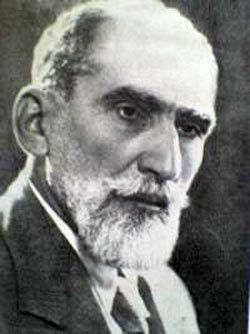 In combat with tenacious massive stones he created images of famous sons of the fatherland, who increased glory of Georgia - Ilia Chavchavadze, Akaki Tsereteli, Vajha Pshavela, Ivane Javakhishvili, Chakhrukadze .. Images of these writers, public figures were embodiment greatness of native people for him.
In combat with tenacious massive stones he created images of famous sons of the fatherland, who increased glory of Georgia - Ilia Chavchavadze, Akaki Tsereteli, Vajha Pshavela, Ivane Javakhishvili, Chakhrukadze .. Images of these writers, public figures were embodiment greatness of native people for him.
It is no wonder therefore, that Jacob Nikoladze's creativity was accompanied with Rustaveli theme. Keen interest to the great Georgian poet has appeared at Nikoladze already in boyhood when in a bookshop of his brother he had seen magnificently designed “The Knight in the Panther's Skin” with illustrations by Mihály Zichy (Hungarian artist, (1827 - 1906) .
J. Nikoladze came back repeatedly to the Sh.Rustaveli’s image. He is the author of first sculptural portrait of Rustaveli. Nikoladze created it at the beginning of independent work and exposed it in Kutaisi. The sculpture was purchased by patron of art Zubalashvili who subsequently has taken it away to Florence. Second portrait Rustaveli created on the same sketch (differing from the first in sizes) was shown on the fifth exhibition of works of the Caucasian artists in Tbilisi in 1897. The sculpture has caused interest of the public was granted Ilia Chavchavadze's approval.
Though the general contours of Nikoladze works on Rustaveli theme evoked tradition, each sculpture testified growth of his skill. The oval bas-relief of the poet with arch-like cut by J. Nikoladze's has sustained check by time. Today, when we know the image aged Rustaveli on the wall of the Jerusalem Monastery of the Cross, the bas-relief  by Nikoladze seems most close by this image.
by Nikoladze seems most close by this image.
The first attempt of a sculptural illustration of a poem also belongs to J. Nikoladze. Therefore it is quite natural, that he has appeared among those admirers of Rustaveli genius who had been surrounding glorified Russian poet Konstantin Balmont during his stay in Georgia.
Since Ilia Chavchavadze's times and his colleagues Rustaveli related activity was considered of great public significance. Researchers of Rustaveli creativity, his publishers and collectors of manuscripts, folklore, popular writers of his ideas, artists, translators in prose and verses, commentators, initiators of creation of a monument to the poet and « Rustaveli Society», oral storytellers and admirers “The Knight in the Panther's Skin” have revealed to Balmont Rustaveli’s native land. Balmont had apprehended general love, which Georgians usually displayed upon their poets and poetry in general, as an attribute of high spirituality of people, and reverence of Rustaveli – as an expression of their national pride. “The Knight in the Panther's Skin,” was likely a key opening a way to realization of more courageous cultural plans.
At that time on arena of a cultural life the new generation of intellectuals and writers of the first decade of a new century has acted. The majority of them had received education in Russia and Europe. They had continued activities of the famous predecessors with honour and had planned new ways to development of a domestic science and culture. Thus the name of Rustaveli invariable had been remaining in the center of this cultural rise.
Balmont's arrival to Georgia, his poetic oath -
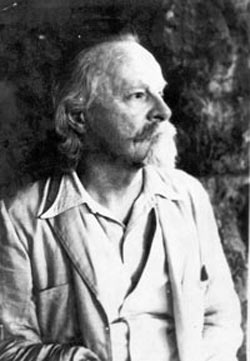 «I am a Slav,
«I am a Slav,
And I swear
A relic of Georgia
Rustaveli poem
To reveal with my poetic pipe... »
(Informal translation by Dr. Teimuraz Kancheli)
- Have increased and have united those who had been interested by creativity of Rustaveli, promoted updating of feeling of national optimism.
Balmont's interest upon Rustaveli’s creativity was met by the Georgian society with unprecedented enthusiasm. It was perceived by contemporaries as a meeting of two geniuses. Indeed, “The Knight in the Panther's Skin” translation by Balmont gave a new, second life to work of literature in a mullions-strong Russian society, and on this background the spiritual union of two nations seem to be stronger.
The press of that time widely covered Balmont's stay in Georgia. Numerous representatives of different layers of a society attended Rustaveli devoted literary evening which were given by the poet. «My work has found those who required it... It receives other, joyful sense», - one could read in his letters.
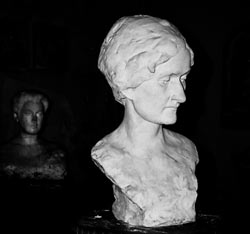 Jacob Nikoladze belonged to a cohort of Balmont friends. It is significant, that J. Nikoladze created fourteen out of twenty works on Rustaveli theme, during Balmont's work on poem down to publishing of full text of his translation in 1933. About acquaintance of the sculptor and the poet in general I already motioned in the book «Balmont and Georgia» (1972) where friendly environment of the poet in Georgia and kindliness of Alexander Kancheli's family who has hosted the poet were described.
Jacob Nikoladze belonged to a cohort of Balmont friends. It is significant, that J. Nikoladze created fourteen out of twenty works on Rustaveli theme, during Balmont's work on poem down to publishing of full text of his translation in 1933. About acquaintance of the sculptor and the poet in general I already motioned in the book «Balmont and Georgia» (1972) where friendly environment of the poet in Georgia and kindliness of Alexander Kancheli's family who has hosted the poet were described.
In conversation with deputy director of the Museum of Arts of Georgia Simeon Bolkvadze I have learned, that Jacob Nikoladze modeled a bust of A. Kancheli’s wife - Tamar Amirejibi (Amiredzhibi). Working on the book about Balmont, I become closer friend with families Kancheli and Amirejibi, however about Tamar Kancheli's bust I heard nothing. I visited Jacob Nikoladze's workshop where I met with his grandson, young sculptor Guram Nikoladze. I’ve got acquainted with Jacob’s wife – Bronislava Georgievna, unique and sole inhabitant of this house. She has benevolently concerned to my searches, remembered this work of the sculptor entered by her in the catalogue of his works, but she did not know where it was. The bust made in plaster in the sizes 33x19x20 cm, is included in the catalogue of works of J. Nikoladze in 1912 (or 1914).
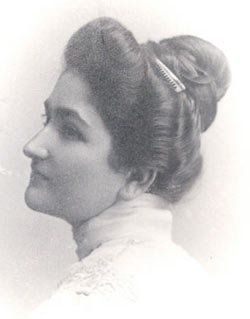 Tamar Amirejibi, (1884 - 1917), mother of three sons, was educated woman. She was brought up in cultural family with good traditions. Her brothers were the engineers. Kutsna Amirejibi was educated in St. Petersburg and Giorgi Amirejibi in Aachen (Germany). George Amirejibi was besides the publisher of the newspaper «The Transcaucasian speech» on which pages the events connected with stay of Balmont in Georgia were widely covered.
Tamar Amirejibi, (1884 - 1917), mother of three sons, was educated woman. She was brought up in cultural family with good traditions. Her brothers were the engineers. Kutsna Amirejibi was educated in St. Petersburg and Giorgi Amirejibi in Aachen (Germany). George Amirejibi was besides the publisher of the newspaper «The Transcaucasian speech» on which pages the events connected with stay of Balmont in Georgia were widely covered.
After the graduating from Female Grammar School Tamar Amirejibi had received secular education and in addition fine arts (probably, in the Tbilisi Private School by princess E. Tsereteli, who was a pupil of Parisian professor Liugren). She was trained in art printing on metal-based laminate, mosaic on a leather, groove on a marble, burning out on a tree. Almost century old works of Tamar Amirejibi are kept in family of her grandson (Dr. Teimuraz Kancheli).
Tamar Amirejibi was a member of "The Society of the Georgian women». The house of Kancheli family was one of the centers of a cultural life of the city. On Thursdays well-educated society gathered there, outstanding figures of art and literature used to come. In this house Balmont’s translation of «The Knight in the Tiger Skin» was read for the first time. Balmont devoted many verses and impromptus to the Georgian friends, and in the foreword to translation of the «The Knight in the Tiger Skin» he has expressed gratitude to Kancheli spouses, spiritual dialogue with whom has inspired him on this titanic work and has helped him to finish it.
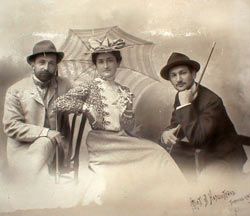
Tamar Amirejibi-Kancheli's inner life has induced Jacob Nikoladze to immortalize image of this fine Georgian woman in a sculpture. Female portraits take a considerable place in his creativity. Some of them are also anonymous. In his workshop a plaster cast female portrait resting on wooden mezzanines drew my attention (Mrs. Lia Andguladze). It has reminded me a face of Tamar Amirejibi familiar to me from photos. The bust as the family property had no museum number and was called as "The Female portrait».
All Tamara's the most successful photos concern to a time of her girlhood. But now, at a general view and according to hairdressing, clothes a graceful Georgian woman of the beginnings of a century appears. The female head which have been found out on mezzanines of a workshop of the sculptor does not have high hairdressing of magnificent hair, underlined beautiful eyes and oval face. I found similarity of a sculptural portrait to Tamar Amirejibi, but similarity of completely not of external view. Thoughtful, the sight turned inside, the Georgian features which have been lit up by internal light, emphasized spirituality of shape. I already trusted that she is Tamar Amirejibi. Such, should be, she faced to the sculptor, and he with feeling of a measure inherent in him has transferred internal harmony of this fine woman.

Acknowledgement of the guess I searched at Tamar’s grandson - young physicist Teimuraz Iraklievich Kancheli. He agreed to visit I.Nikoladze's house-museum under my request. Sharp electric illumination has somehow changed features of a sculpture. Teimuraz did share my confidence. But Guram Nikoladze, the sculptor, has supported me, considering the bust, and a photo are the image of one type of the face.
The last word was for Tamar’s son – Vakhtang Kancheli (Teimuraz Kancheli note: 1908 – 1990). He has arrived from Moscow where permanently lives, to Tbilisi in connection with death of the stepsister well-known Georgian actress Salome Kancheli (Teimuraz Kancheli note: 14.05.1921 – 15.12.1985). On a photo of disputable sculptural portrait he has made an inscription in Russian: «This bust of my mother - Tamar Rosebovny Kancheli, née Amirejibi, - for many years stood at our house. Vakhtang Aleksandrovich Kancheli, 17.12.85» (Teimuraz Kancheli translation). Henceforth the bust of work of J. Nikoladze will carry a name of the woman was inspirer not only the Georgian sculptor, but also the Russian poet.
During work on Rustaveli’s poem Balmont corresponded with Tamara and Alexander Канчели. His letters certificate love and fidelity of Russian poet to Rustaveli and his compatriots’ native land. The same also eloquently confirms the telegram sent by him from Paris to Kancheli: “MZE MIKVARXAR KATLI” (Teimuraz Kancheli’s translation: «The Sun, I love, Georgia») which Georgian words have been typed by a roman script. In 1917, having kept his word, the poet finalized the translation of poem  and has brought it to Georgia. Still being to Russia, in the letter to his relatives he wrote about a forthcoming exciting meeting: «Also I think, how before Georgians I shall take in hands... my work, I turn pale also and cry, as Rustaveli’s heroes».
and has brought it to Georgia. Still being to Russia, in the letter to his relatives he wrote about a forthcoming exciting meeting: «Also I think, how before Georgians I shall take in hands... my work, I turn pale also and cry, as Rustaveli’s heroes».
Balmont has executed the oath, but the deep grief has saddened his pleasure - Tamar Amirejibi had been living her last days. «Only force of soul allows this tormented body to not die absolutely», - we read in a letter of the poet. In one of following messages to the family he informs: «... Tonight I, prince Amirejibi, prince Diasamidze and Alexander Kancheli on a stretcher have taken down Tamara from height, where her summer residence (“dacha”) is and where she choked, downwards on a coast of Borzhomka (Teimuraz Kancheli note: a river near Borjomi city). Yesterday it seemed, she will die. Today she is better». However on July 6, 1917 she died. She was thirty three years old. Balmont attended a funeral in Tbilisi. Here is how he writes about this: «Yesterday we have buried Tamar. There were a lot of us who were seeing off. The coffin was completely covered by flowers, and from me were much... Roses and a white tape: «To the best Georgian - Tamar Kancheli from Balmont, in the name of her sung in Russian the whole Rustaveli poem». I still unable to understand, that Tamar really is not present. I am sending my verse to Tamara».
Balmont’s posthumous dedication «In Tamar Kancheli's Name» was published in the newspaper «Sakartvelo» (July 10, 1917). And now many remember it by heart:
Для меня опустела Картвелия,
Мой светильник погас, догорев,
Для кого же принес Rustaveli я,
Облаченного в русский напев?!
(in Russian)
Georgia has become empty for me,
My lampion went down, having burnt down,
For whom I have brought Rustaveli,
Clothed in Russian tune?!
(Word-for-word translation by Dr. Teimuraz Kancheli)
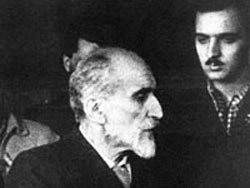 So, many representatives of the Georgian public of the beginning the centuries excited creative imagination of Jacob Nikoladze, were well-known to Balmont. He saw sculptural portraits of some of them in a workshop of the artist. The poet was familiar with Georgian literature classical writers and poets since the time of the first arrival to Georgia in 1914. The author of these “live” pictures the «Pantheon of the Georgian poetry» was Jacob Nikoladze.
So, many representatives of the Georgian public of the beginning the centuries excited creative imagination of Jacob Nikoladze, were well-known to Balmont. He saw sculptural portraits of some of them in a workshop of the artist. The poet was familiar with Georgian literature classical writers and poets since the time of the first arrival to Georgia in 1914. The author of these “live” pictures the «Pantheon of the Georgian poetry» was Jacob Nikoladze.
During the searches connected with a bust of T.Kancheli, a poem written in Russian in Bronislava Nikoladze’s book «Memoirs of the sculptor» attracted my attention. It was brought among anniversary (1922) greetings to Jacob Nikoladze. According to style, genre, an art manner it very much reminded Balmont-written opus. The impromptu named sonnet was brought in the book in shorthand form. Misses have been dotted. It is known, that Balmont dared to deviate from the scheme of a sonnet loved by him, sometimes entered a superfluous line and I thought reductions were also possible; but the dots become alerted.
And the date of a writing raised the doubts - per 1922 (year of J.Nikoladze’s anniversary) Balmont did not come to Georgia. The autograph of the poet which Bronislava Nikoladze promised to look for at home when searches in the Literary Museum of Georgia have appeared unsuccessful could resolve my doubts.
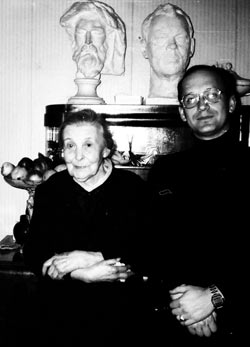 Objectively the pros and cons Balmont's authorships were equal, but the internal belief was prompted me, I am on the right way. Bronislava Nikoladze, closely listened to me, nevertheless considered, that the impromptu could be written by Alexander Kancheli - close friend of Jacob Nikoladze and the brilliant expert in Russian language.
Objectively the pros and cons Balmont's authorships were equal, but the internal belief was prompted me, I am on the right way. Bronislava Nikoladze, closely listened to me, nevertheless considered, that the impromptu could be written by Alexander Kancheli - close friend of Jacob Nikoladze and the brilliant expert in Russian language.
Among the poets surrounded J. Nikoladze, apart from Alexander Kancheli, Valerian Gaprindashvili, Cyril Zdanevich, Paolo Yashvili, Alexander Abasheli. Kote Makashvili had been writing verses in Russian. However I considered improbable that somebody from them has addressed to Nikoladze in Russian.
Wishing to find the truth, Bronislava Nikoladze asked to me "tricky" questions, such, for example, as: «Why Jacob decided to hide from me the fact, that the sonnet was devoted to him by Balmont?». It was logical to be proud of this fact, instead of to hide it.
In the answer I considered the following: Bronislava Nikoladze became the wife of the sculptor in 1925. The sonnet could be written before 1917, and in anniversary materials it has appeared by virtue of the dedicational character. By 20-th Balmont was already in emigration, and the name of the poet in a circle of his Georgian friends was ignored (Teimuraz Kancheli - because of dangerous nature of mentioning such people in Stalin repression machine conditions). Besides Jacob Nikoladze never mentioned, that the sonnet is devoted to him by Kancheli or Zdanevich.
Bronislava Nikoladze has found out a sonnet after Jacob Nikoladze death and, having felt originality of talent of its author, has cited it in the book «Memoirs of the sculptor». She remembered the autograph of an impromptu very well - a thin sheet of a paper on which the text was written in block letters with black pencil. I have brought to her the autograph of one of Balmont’s poems for comparison. Bronislava Nikoladze examined the 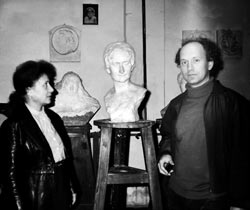 fine, densely pressed to each other letters for a long time, but could not tell anything consolatory. Boldness of handwriting on the autograph which was kept in Bronislava Nikoladze’s memory, did not allow her to agree with my assumptions. I tend to explain this metamorphosis with Balmont's handwriting by thin paper and a drawing pencil the text was written with.
fine, densely pressed to each other letters for a long time, but could not tell anything consolatory. Boldness of handwriting on the autograph which was kept in Bronislava Nikoladze’s memory, did not allow her to agree with my assumptions. I tend to explain this metamorphosis with Balmont's handwriting by thin paper and a drawing pencil the text was written with.
Balmont had very special attitude to words: he used to write some nominal nouns with a capital letter, for example: the Sun, the Sea, the Georgian, Love, the Spaniard...
When in some weeks Bronislava Nikoladze has found the autograph of the sonnet and has shown it to me, it didn’t remain any doubts at me. It was Balmont's handwriting! A sonnet written by his hand, with his favorite capital letters - the Assyrian, the Apostle! It was the full text of a sonnet, and lines omitted before contained convincing confirmation of my guesses (they are underlined in the text). I exulted, but nevertheless have found necessity to receive written acknowledgement of authorship of Balmont from his daughter - Nina Konstantinovna Balmont-Bruni. I have sent a x-copy of the autograph of the sonnet to her:
In Russian
ЭКСПРОМТ-СОНЕТ
Я. Николадзе
Тебя люблю и взор тобой дивится.
Твои глаза, как главы двух ворон.
Ты проводник печальных похорон,
И ты пуглив, как юная девица.
Меня пленит твой профиль Ассирийца,
Когда взойдешь, как новый фараон
На новый пьедестал, на новый трон -
Чело твое сияньем озарится.
Тебя томят... И чуется измена.
Но ты взлетишь, чтобы познать зенит,
И запоет твой пламенный гранит.
О, дивный жрец, сошедший с гобелена,
Живой привет сонетом говорит
Живой поэт - Апостолу Родена.
IMPROMPTU-SONNET (In English)
Y.Nikoladze
I love you and my eye marvels at you.
Your eyes, as ravens’ two heads.
You a conductor of sad funeral,
And you are timid, as the young maiden.
I am captivated with your profile of the Assyrian,
When you will mount, as the new pharaoh
On a new pedestal, on a new throne -
Your brow will light up with radiance.
They languish you... And treachery is felt.
But you will fly up, cognize zenith,
And your ardent granite will start singing.
Oh, marvelous priest who has stepped down from a gobelin,
Alive greetings speaks with sonnet means
The alive poet - to Rodin’s Apostle.
(Informal translation by Dr. Teimuraz Kancheli)
Already two years as Nina Konstantinovna Balmont-Bruni on a state of health cannot arrive to Georgia (Teimuraz Kancheli’s note – the article was written in 1986, she died in Moscow in 1989), breaking that nice tradition. Some of her letters are already written by other’s hand. She sharply experiences the feebleness; born in the first year of XX century, she kept vivacity for long time. To me Nina Konstantinovna Balmont-Bruni has written the reciprocal letter itself. She did not challenge Balmont's handwriting, but some comparisons in a sonnet so jarred on her, that she was inclined to think, that the script counterfeit Balmont’s handwriting. She wrote: «He always signed the verses... A farfetched rhyme of "sad funeral», expression «timid, as the young maiden» is alien for him, and these «raven’s heads» (it is monstrous!). I can not believe, that Balmont compares eyes of the person of art to them... He was always exact in definitions! » Nina Balmont-Bruni was interested in the opinion of the wife of the sculptor in this occasion.
It became clear: ignorance of some realities connected with creation of the sonnet, in due time has defined also free reduction of lines of a sonnet by the editor, and now has raised the doubts of Balmont’s daughter. It was necessary to open the contents of a sonnet in its basic lines, to show, how names of Balmont, Nikoladze and Kancheli, «friends to heart», again were built in one line.
Thus, a line «Your eyes, as ravens’ two heads » Has jarred on the daughter of the poet, but it is prompted by great wings, black plumage, a clever and sharp-sighted sight of a bird which image bears color loading in the sonnet. Explaining this line, Bronislava Nikoladze writes: «I quite agree with Nina Konstantinovna. This line does not answer a poetic aesthetics and consequently it was unique which I have omitted in the book. The others - editors. However comparison - not without the bases: Jacob Nikoladze had deep eye hollows, sharp-sightedly looked eyes with the long black eyelashes extending them».
About a line “And you are timid, as the young maiden” the wife of the sculptor writes: «Jacob Ivanovich, as well as many people of creativity, was excessively vulnerable. He did not endure not only roughness, but also simple tactlessness. Being afflicted, he felt emotional worry, anxiety, became withdrawn and, maybe, even was lost, not finding words for the equivalent answer. It made impression of shyness. His sincere fragility and cleanliness also have prompted the poet the mentioned lines».
The "disputable" line omitted by the editor «You a conductor of sad funeral» has helped us to specify the date of a writing of a sonnet. It is known, that Balmont's arrivals to Georgia in 1914, 1915 were usually accompanied by celebrations. But in 1917 his pleasure has been saddened by illness and death of the close friend of poet Tamar Amirejibi-Kancheli. On memoirs of her son Vakhtang Aleksandrovich Kancheli, Balmont, participating in ceremony of burial of Tamara even has decided to carry the coffin, but, having spared him, he did not allowed to do that.
Thus, under «sad funeral» Tamara's funeral is meant. Thus, the sonnet has been written in July, 1917. Bronislava Nikoladze, as though explaining some haste which appears in other lines of a sonnet, adds the following: the line “You a conductor of sad funeral” makes a hint that the sonnet is written in conditions not relevant to creativity, at the obligatory traditional final stage of funeral – “kelekhi”, which is funeral feast. This process suppresses the poet, having aggravated perception of circumstances. Participants of “kelekhi” drink wine, that has more aggravated feelings and has not kept the poet from desire to compose an impromptu. In such circumstances there were no conditions to soften some expressions though these lines give Jacob Nikoladze’s exact portrait and are pardonable to Balmont in our eyes».
Balmont’s sonnet, apparently, was known to relatives of J. Nikoladze. It proves to be true since we find this idea in comparison of the sculptor with the Assyrian at Geronti Kikodze’s article, devoted to Jacob Nikoladze: «... the appearance he, to some extent, reminds revived Assyrian bás-relief, and by his personality and creativity he represents an organic part of modern Tbilisi».
The wife of the sculptor notes, that Balmont was not the only who compared Jacob Nikoladze with Assyrian. One of friends to her parents - Nevinsky, in his poem gives the same portrait of J. Nikoladze: «... a call, and quickly enters Assyrian demigod... ».
Unimportantly, who the first has seen this similarity, the core is, that it existed and was not casual. In a sonnet probable conversations of the poet and the sculptor on themes close to them were reflected: Egypt, pharaohs, sphinxes, bás-reliefs on tombs, France, Rodin...
Nikoladze, obviously, did not hide from the poet the reasons, braking realization of his plans - indifference of authorities and rich part of a society. « Tbilisi «higher society» negotiators’ tastes of that time did not go beyond problems how to decorate their wives and daughters with gold. There can be no question of private or state orders for a sculpture», - wrote Kikodze.
Indeed, «The Grieving Georgia» on Ilia Chavchavadze's tomb was Jacob Nikoladze's sole work which was issued in pre-revolutionary Georgia. The works of the sculptor did not leave a workshop which was situated at a warehouse then.
The talent and J. Nikoladze's plans deserved support, but he vainly waited for it. The Russian poet certainly sympathizes with the sculptor, but a leitmotif of the sonnet the hope, belief in his future and in a high recognition of his talent sounds. The prophecy of the poet has come true. Radical changes, happened in Georgia the twentieth years, made active an artistic life, J. Nikoladze had been provided all conditions for creative activity which fruits have brought to him national glory.
Balmont's impromptu-sonnet - one of the best poems which he has created on Georgian theme. During Balmont's rapprochement with Georgia when the Russian critics considered his creative potential exhausted, he has lifted the poetic prestige through translation of “The Knight in the Tiger Skin”. Updated by the Georgian source, his poetry has found the second breath. In 1916 the newspaper «Russian sheets», considering the new compilation of the poet "Ash" where his verses from the Georgian cycle had been included, marked, that some verses, for example, "Georgia", "Tamara" (devoted to Tamar Amirejibi), «Say you» (haven red through as an impromptu on grand welcome with Georgians), return to Russian reader Balmont – the author of «Fairy tales».
(Unofficial translation by Dr. Teimuraz Kancheli, All rights reserved).
View photos related to Amirejibi, Kancheli, Palavadishvili families here
To read the article in Russian go to the next page

 Simon Japaridze, who led all important ascents of Kavkasioni in 1926-28, initiated researchers into the study of the
Simon Japaridze, who led all important ascents of Kavkasioni in 1926-28, initiated researchers into the study of the